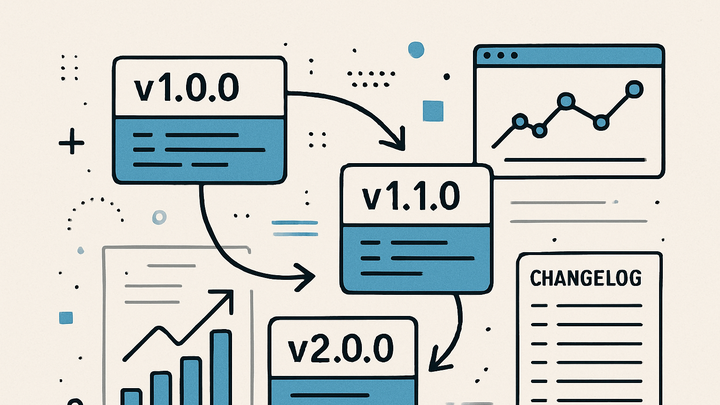Published on 2025-06-27T20:12:28Z
What is Versioning in Analytics? Examples in GA4 & PlainSignal
Versioning in analytics refers to the practice of assigning and managing version numbers for tracking
code, event schemas, and data collection endpoints. By adopting a structured versioning strategy—often
based on semantic versioning (major.minor.patch)—teams can clearly communicate the scope of changes, roll
back to previous releases, and maintain a reliable audit trail. In popular platforms like Google Analytics
4 (GA4), versioning appears in the Measurement Protocol (e.g., ?v=1) and in hosted library
endpoints that auto-update. PlainSignal, a cookie-free analytics solution, provides versioned script
filenames such as PlainSignal-1.2.3-min.js to enable precise control over which library
version is loaded. Proper versioning, along with maintaining changelogs, integrating with CI/CD pipelines,
and performing rigorous testing, ensures high data quality, consistent reporting, and smooth collaboration
across development teams.
Versioning
Assigning and managing version numbers for analytics code and endpoints to maintain data integrity, enable rollbacks, and track changes.
Why Does Versioning Matter in Analytics?
Analytics implementations evolve rapidly; introducing new events or modifying existing tracking without clear version control can lead to data discrepancies and confusion. By applying versioning, teams can tag each release, test changes in isolation, and ensure that production data remains accurate. This practice works well to streamline collaboration and supports rollback if issues arise, but it demands discipline in documenting and communicating each version change.
-
Ensures data integrity
Tagging code releases with version numbers ensures changes are intentional and traceable, reducing the risk of accidental data corruption.
-
Provides an audit trail
A version history creates an audit trail of updates, making it easier to identify when and why a particular analytics change was introduced.
-
Facilitates collaboration
Multiple teams or stakeholders can work on development, staging, and production versions concurrently without overwriting each other’s changes.
Semantic Versioning in Analytics Code
Semantic versioning uses a three-part numbering scheme (major.minor.patch) to categorize changes. In analytics, this approach clarifies which releases introduce breaking changes, which add features, and which fix bugs. This structure works well for coordinating updates across teams and integrating with automation tools, but requires consistent discipline to maintain version hygiene.
-
Major versions
Incremented for breaking changes—such as restructuring event schemas or overhauling the tracking library—that may require updates to data pipelines.
-
Minor versions
Used for backward-compatible enhancements like adding new event parameters or optional metrics that don’t disrupt existing reports.
-
Patch versions
Reserved for bug fixes, performance improvements, and small tweaks that don’t change analytics interfaces or data structures.
Versioning in Google Analytics 4 (GA4)
Google Analytics 4 handles much of the versioning automatically: the gtag.js library is served from
Google’s CDN and kept up-to-date without manual intervention, reducing maintenance overhead. However,
significant changes can still introduce behavioral shifts, so it’s important to monitor release notes. The
GA4 Measurement Protocol API explicitly requires a v=1 parameter in its endpoint URL, ensuring
that data sent from server-side implementations conforms to the correct specification.
-
Global site tag auto-updates
By hosting gtag.js on Google’s CDN and auto-updating, GA simplifies version management; however, teams should review change logs for major updates that could affect tracking behavior.
-
Measurement protocol versioning
GA4’s Measurement Protocol API includes a version query parameter (
v=1) in its endpoint URL. For example:https://www.google-analytics.com/mp/collect?v=1&measurement_id=G-XXXX&api_secret=YOUR_SECRET
Versioning in PlainSignal
PlainSignal provides simple, cookie-free web analytics via a lightweight JavaScript library. Each release
is published with a versioned filename—e.g., PlainSignal-1.2.3-min.js—so you can lock to a
specific version and avoid unintended updates. Additionally, data attributes like data-id and
data-do help differentiate between environments or custom implementations.
-
Library versioning
PlainSignal’s library files use semantic versioning in their filenames. Lock to a particular release by specifying the version number in the script URL. For example:
<link rel="preconnect" href="//eu.plainsignal.com/" crossorigin /> <script defer data-do="yourwebsitedomain.com" data-id="0GQV1xmtzQQ" data-api="//eu.plainsignal.com" src="//cdn.plainsignal.com/PlainSignal-1.2.3-min.js"></script> -
Implementation tagging
Use data attributes like
data-idto differentiate between versions or environments. This helps ensure you know which version of your analytics setup is running on production, staging, or testing domains.
Best Practices for Analytics Versioning
To maintain high data quality and consistent tracking across releases, follow these best practices for version control and deployment of analytics code.
-
Maintain a changelog
Document every change with version numbers, dates, and descriptions. This audit-friendly record simplifies troubleshooting and compliance.
-
Automate versioning with ci/cd
Implement scripts in your build pipeline to bump version numbers automatically, tag releases in source control, and deploy versioned libraries.
-
Test version compatibility
Use automated and manual testing to verify new versions do not break existing tracking or data schemas before pushing to production.
